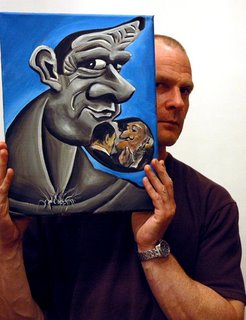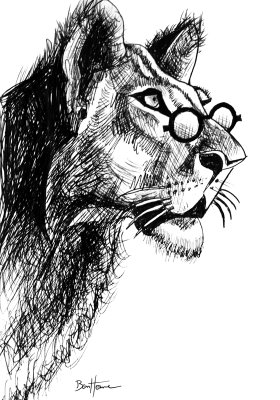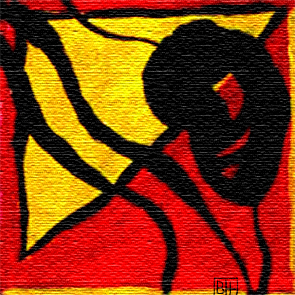.
The warrior tilted her face
Inspired by Quasar9
 Jeremy, Bernd, Henning, Rohan
Jeremy, Bernd, Henning, Rohan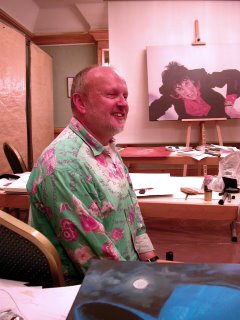
Jurgen
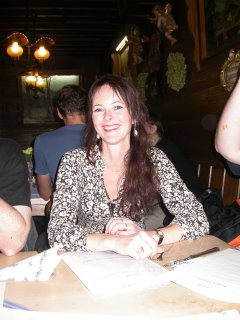 Siv Grethe
Siv GretheWarm thanks to Siv Grethe for sending me those pictures.

The NCN was formed in 1989 by Wallace "Buddy" Rose. Buddy created a forum for caricaturists by providing a quarterly newsletter and annual convention. The original goal was to create an organization that would seek out charitable and mutual benefits for united artists. It operated briefly as a booking agency until filing its application in compliance with article 5154a making it a trade union in 1994. In 1995 the new constitution was ratified in San Antonio, TX, the NCN was granted non-profit status, and the first election was held. In 2005, the NCN was changed into a non-profit, unincorporated association.
To achieve what war cannot;
.
.
The truth.
.
King Ludwig II of Bavaria was born in Nymphenburg Castle outside Munich in the early hours of August 25, 1845. He was the eldest son of King Maximillian II and Queen Marie, and was named after his grandfather, King Ludwig I.
Ludwig's Childhood
As a boy, Ludwig was given a typical 19th century upbringing - an indifferent father and schooling which consisted of constant beatings. It is fairly obvious that he would have been miserable as a child. His favourite times of the year were the summer holidays the family spent at the Royal Castle Hohenschwangau which King Max had restored between 1832 and 1836 in a romantic medieval style. Hohenschwangau's position can only be called magnificent; it is situated beside a blue alpine lake, the Alpsee, and about 2 kilometres from the Austrian border and the Tyrolean Alps. The Royal Family in 1862. Left to right, Ludwig, Queen Marie, King Max II, Otto. The Queen enjoyed taking Ludwig and his younger brother Otto on lengthy hikes in the nearby alps and it would have been on these occasions that Ludwig developed his love of the mountains and their solitude, as well as his lifelong devotion to the Schwangau region. He also loved to feed the wild swans that lived around the lake, and several drawings of swans that he made at this time survive today.
The discovery of Wagner
In 1858, when Ludwig was thirteen years old, his governess told him of the upcoming production of Richard Wagner's opera Lohengrin, the story of which centres around the heroic medieval Swan-knight Lohengrin. Since the walls of Hohenschwangau were covered in frescoes featuring Lohengrin, a curious Ludwig acquired a copy of the opera's libretto and he read it voraciously. It wasn't too long before the Prince had learnt the entire libretto off by heart, as well as the libretto of another Wagner opera, Tannhäuser. He was soon devouring every book written by Wagner, and on February 2nd, 1861, Ludwig heard a Wagner opera for the first time. Lohengrin, the Knight of the Swan, reveals his identity to the people of Antwerp at the dramatic climax of "Lohengrin". Appropriately it was Lohengrin and the experience left a profound impression on the Prince. In 1863 he acquired Wagner's recently published Ring Cycle, the preface of which contained a comment about the miserable state of the German theatre. In order for the Ring to be produced, Wagner wrote, a German Prince would need to be found to provide the required funds. To Ludwig, this was a direct message from the master. He would be that Prince.
Ludwig becomes King
On March 10th, 1864, King Max died at the age of 53. Ludwig assumed the throne at 18 years of age. Within days of his ascension, the young King ordered his ministers to track down Wagner and bring him to Munich. The task was not as easy as first thought, but eventually Wagner, running from his creditors, was located in Vienna and brought to the King. To the 51 year old composer Ludwig was a new Siegfried, come to rescue art. To the 18 year old King, Wagner was a god. Ludwig became Wagner's patron, settled his debts, and set him up comfortably in an Italianate-style villa. The two were inseparable, and Ludwig was soon planning the construction of a large festival theatre in Munich. On several occasions Wagner stayed with Ludwig at Schloss Berg, another mock-Gothic summer castle, as well as visits to Hohenschwangau. Richard Wagner photographed at about the time he met Ludwig.
The tide turns
Soon, however, Munich society was growing tired of Wagner's arrogance and jealous of his influence on their young King, and the ministers feared Wagner would try to influence Ludwig in political matters. It was only a matter of time before Wagner was forced to leave Bavaria. Eighteen months after his arrival, Wagner left Munich for Switzerland, and to a house rented by Ludwig for him. Ludwig fled to Hohenschwangau. The one thing that was giving him happiness had been taken from him.
War
The first few years of Ludwig's reign was a series of tragedies and disappointments. In 1866 war broke out between Austria and Prussia, the most powerful of the German states in what became known as the Seven Weeks War. Because of Bavaria's strong links with Austria, she too was drawn into the conflict on the Austrian side. Unfortunately for Bavaria, Prussia was victorious, and the country was thrown into gloom. In a secret treaty Ludwig placed the Bavarian army at the disposal of the Prussian General Staff. A part of Bavaria's independence was lost.
The honeymoon ends
The date for the wedding was first set for August, 1867. Shortly after it was changed to October 12th, the date both Ludwig I and Max II had married. But it was beginning to be obvious that not everything was well. Ludwig and Sophie were seen occupying separate boxes at the theatre, and people remarked that the couple seemed to be lacking a glow. Further evidence of this happened when Ludwig left court balls early and alone in order to catch the final act of plays. The truth was that Ludwig was desperately worried about the wedding. He stated to the Court Secretary that he would rather drown himself in the Alpsee than to marry. As the wedding date dew nearer Ludwig was more agitated and miserable. He wrote to Wagner "Oh, if only I could be carried on a magic carpet to you . . . at dear, peaceful Tribschen (Wagner's house in Lucerne, Switzerland.) - even for an hour or two. What I would give to be able to do that!" But Sophie was just as miserable. She knew that the King didn't love her. Finally she sent a letter offering Ludwig his freedom. But rather than except it, yet another postponement was made, to December.
"The Dream King"
Ludwig was quickly changing in both mind and body. Photographs show how his appearance changed from a slender youth to a huge man in just a few years. He began to spend all his time in the mountains, at Hohenschwangau and Linderhof when it was ready to move in to, and his small mock-Gothic castle at Berg, beside Lake Starnberg. He refused to see his ministers and preferred the company of the mountain people. In fact, the only time he stayted in Munich was the annual investiture and banquet given in the Residenz for the Knights of the Order of St. George, Bavaria's highest Order of Chivalry Ludwig was the Grand Master of this Order. From paintings of these dinners, we can see Ludwig enjoyed himself immensely. The famous "Private Performances" also date from around this time. Sitting alone in the Residenz Theatre or the Court Theatre in Munich, the King would attend plays, concerts and operas put on for him alone. Plays were commissioned by the King to take place in settings designated by him. These settings were invariably exotic; the Himalayas; the court of Louis XIV; Tibet, Imperial China etc. The final trauma for Ludwig occurred shortly after Prussia's victory in the Franco-Prussian War. Bismark requested Ludwig's approval for Bavaria to enter a unified German Empire with Prussia as leader. After several days procrastinating, Ludwig agreed and wrote a letter inviting Wilhelm II to become Emperor of a united Germany. Bavarian sovereignty became an idea rather than a reality, and Ludwig a figurehead in a constitutional monarchy. These incidences, then, were responsible for his reclusive existence, and his alleged "madness". The world had never been kind to him, and he withdrew from it into a world of his own making. This was the reason for his castles.
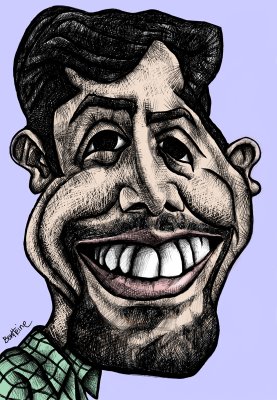
Collective Interview with Hadi Heidari by channel 4 (England)
JULIAN RUSH: The road to the Iranian nuclear crisis began here 32 years ago, under the shah, with the start of construction of the German-designed Bushehr nuclear power station. We were escorted to the site, but no restrictions were placed on what we could film. It's now 90 percent complete, with a thousand-megawatt Russian reactor inside. Iran insists its nuclear activities are nothing but peaceful. This a standard civil reactor, nothing sinister here, the message.
I don't think I need an explanation. The big guy is Russian with a knife behind his back.
دوستی هسته ای ایران و روسیه/ کیوان زرگری
Cartoons by Hadi Heidari
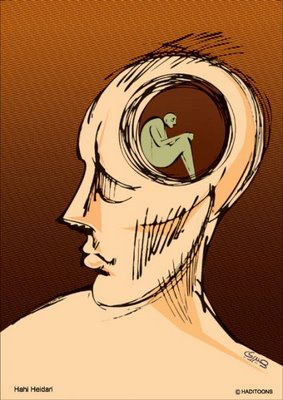
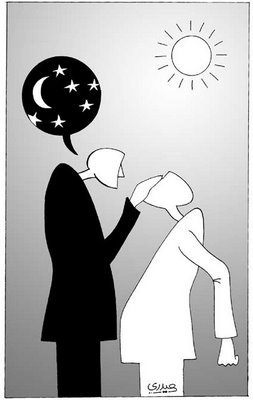
This interview first appeared on Persian Cartoon
I compel you to love your country.
To draw her into your arms ever so tenderly,
To embrace her softly, dearly to your heart,
To huddle close, near together her masses,
And sense her least sustained yearning.
I compel you to love your country.
A nation that lifted the breast of humanity
Caressing it tenderly toward equality’s rapture
With gentle fingers of selfless, searing desire
Exploring over her ever toward paradise.
I compel you to love your country.
Freedom lovers damp in stiff-limbed writhing
Stumbling kisses upon red-barreled bravery,
Softly probing her robust and supple liberty,
Heed now her cries of woeful sovereignty!
I compel you to love your country.
Between her Trail of Tears and Mount Misery
She still waits upon the coupled plains of affection
Ready for our design and mastery of this worlds love
Panting heavy expectation upon her shape.
I compel you to love your country.
Perched upon the shore of Rolles Creek she waits
With Mount Pleasant in reach of her willing fingers.
With expectant sounds of closure now within her folds
She lunges forth with an expectant mouth!
I compel you to love your country.
O! Gentle sleep now beckons to her languid pink flesh
As the rogues tongue laps at her ebbing shores of joy
And beckons her let go of her valuable love’s embrace
Lunging forth behind her eager lips!
She counters not… for she is the boiling hunger we seek.
What a devoted worship we’ve had with the motherland.
Many a great poet has written their songs upon her flesh;
Their bright and shimmering waters lapping her shores
In ardent freedom’s want of hopes howling, dripping heat.
I compel you to love the world!
On this day of days let us remember her youthful glow,
Her ripe fruit of wonder, her drowsy ache of emancipation,
Her most alluring burnish upon our exploring of her skin.
(The burden of immense throbbing now falls upon her heart!)
I compel you to love the world!
America, carry your waves to all shores. Hope, not savagery,
In your goodness, not in impudent desire to control destiny.
Leave not the naked child, but your desire alone on the road.
Shelter not your intentions, but those most needful and hungry.
I compel you to love the world!
We have been witness to our dove, crippled and flailing in terror!
We’ve been onlookers to our expectations emerging fruitless.
Watching unmoved while our oily desire bleeds into the waters
And the cold white eyes of death tread progressively before us.
I compel you to love the world!
Come now, peace. Come now, warriors, lay down your guns
To witness the beauty at your hands as she lays down your sword
And with dripping red lips envelops your craving to possess her.
Do you not hear the night voices calling you with an angels whisper?
I compel you to love the world!
To open the door and step out into the bright sun, desire can wait.
Take notice of the many tender, breathing, soul-caked living.
Gaze upon the world’s most unbendable faith in humanity.
Gently touch her skin, delicately massage her furious soil.
I compel you to love the world!
Enter her sculpting space and weave a covering made of lifeless war
.Paint upon her face a gentle art made of your temples sweat.
Scribe a love song upon her back with the eagle’s most willing blood.
Erect in her a tower of light for all to see that they might weep.
I compel you to love the world!
The masses of age lie here and we should not be so ready to die
Like confused animal’s hooved in selfishness, deficient and artless.
The world is full of freedom lovers damp in stiff-limbed writhing
Stumbling kisses upon red-barreled bravery, tenderly probing liberty.
I compel you to love the world!
Amid her supple lands and majestic mountains she waits our affection,
Ready for our desire and design embracing her most ready warmth
Needing our hot hope upon her shape, wanton as wide-eyed first love.
(Heed now the world’s hot desire for freedom pulling us in.)
With hopeful whisper's within her waters, she leans forth, expectant.
Copyright © 2006 mrp / thepoetryman
Original "Thrusting" Post
.jpg)
In the gleaming of our time together in freedom
We watch the hand choose its own new beginning.
It is strange that only now, as the world hemorrhages,
Do we sense a resurgent vigor of our treasured being.
Our neighbors are holding hopeful that we proceed
And that our hearts can quell the rumbling earth.
Anon comes our most extraordinary occurrence
Which we, with wild modesty of our grand estate,
Do pray angels might hover within our strain
Stuffing the dreary look with the consult of truth
And burst forth with a great cry of liberty
That she shall, within our hands, forever remain.
Copyright © 2006 mrp / thepoetryman
INTERNATIONAL DON QUICHOTTE CARTOON CONTEST
.
.
.
.
.
In Oxycontin did you, Rush Limbaugh
With hypocrite-sheathed debasement
Mock these tremors in crippling jest.
And through politico-rant, sat it down,
Swaying and twisting in foolish disrespect.
.
So within this image we’ve found
The brazen bully bent and heaving,
Contempt emblazoned, red cheeked
Where blossomed his pain relieving
And thrust the truth back upon him.
.
O! His cavernous vile soul is slanted,
Slipping toward the aural hole of anguish;
A beastly grotto as evil and as violated
As the servitude to an empire’s dominion.
And from this abyss, with swaying havoc mad,
As if his words and shifting were child’s play,
He rages that a potent pill untaken what caused
Such feigned extension; an act, an actor, a fake!
Amid a swift and swaying disease a script is penned;
Progressed shaking and incurable neurological cues
Slowness, rigidity, tremors beneath a hopeless flail.
.
You Goddamned cretin! You bile crammed carcass
Wrenching your addiction across the air and ear,
Years now, tormenting even those who’ve died for you!
Your fans are desolation’s addicts, you, their conduit!
This loudness now reached measureless despicability
And sunk into tumult upon your self-seeking airwave,
And we’ve heard, been witness of your disgrace,
Now a crippling tremor setting fire within our stillness;
Inexorable Goddamned torrent of swaying hell shaking us all!
So within this image we’ve found
The brazen bully bent and heaving,
Contempt emblazoned, red cheeked
Where blossomed his pain relieving
And Thrust the truth back upon him...
Copyright © 2006 mrp / thepoetryman



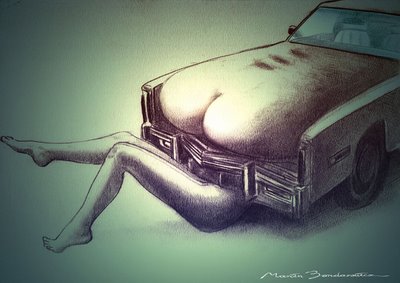
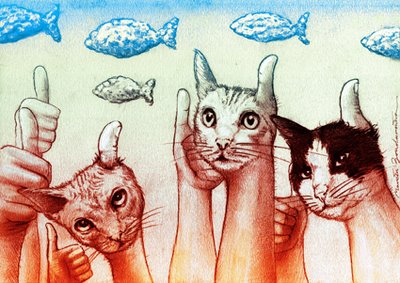
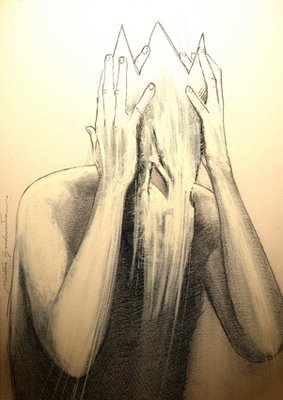











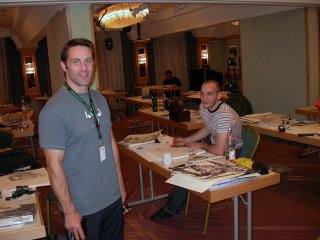




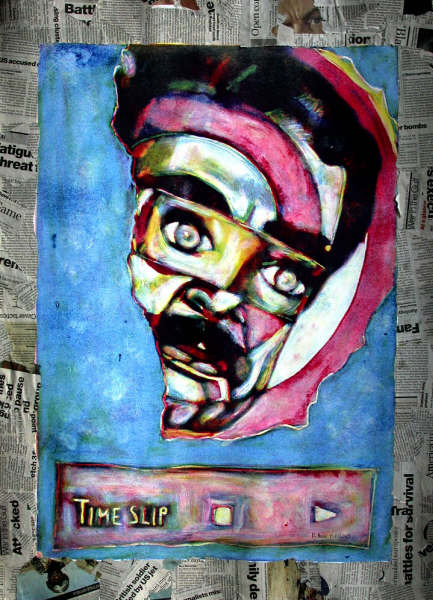
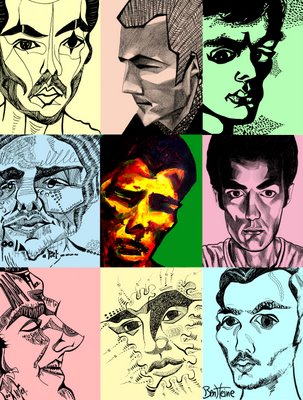


 Ben Heine by Henning Ahlers
Ben Heine by Henning Ahlers


